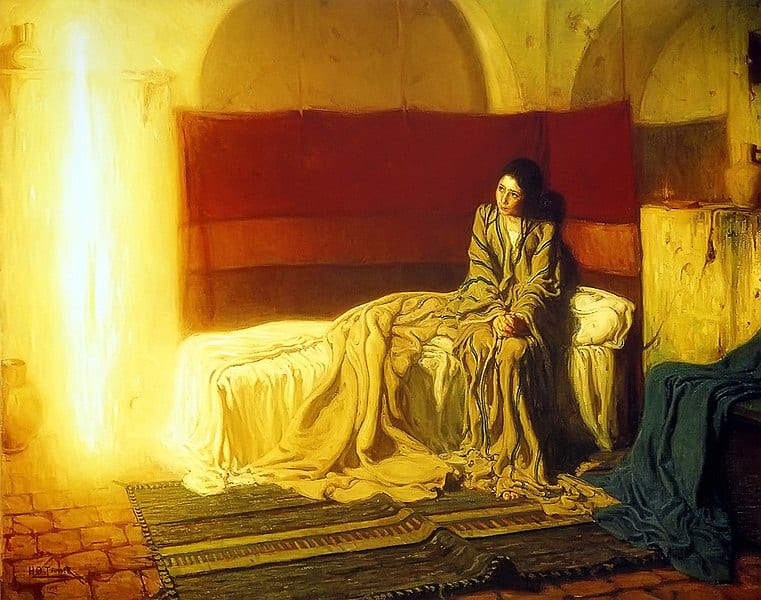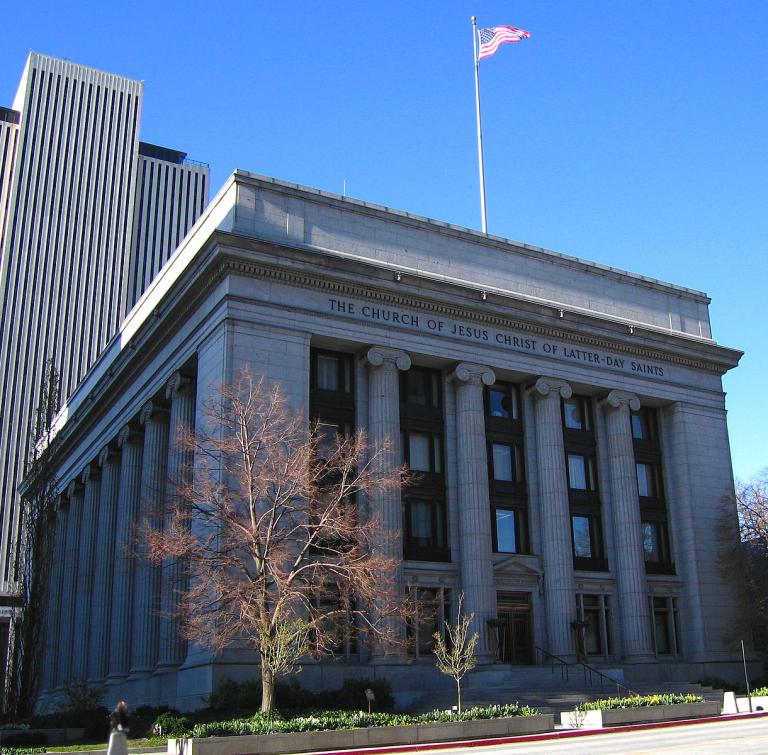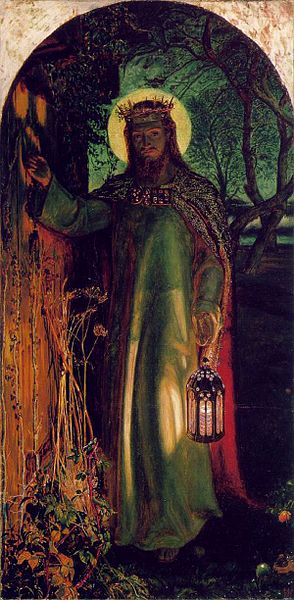
(Wikimedia Commons public domain image)
I encourage you to watch and to share the eighteen-minute video that the Church of Jesus Christ of Latter-day Saints prepared a few years ago for the Christmas season. It is called The Christ Child, and it is, in my opinion, very, very well done: The Christ Child: A Nativity Story. Hard-hearted Scandinavian that I am, there is even a point in the video at which I almost always tear up. (You’ll probably never guess where it is.)
I also encourage you to listen to this video of the male vocal ensemble Chanticleer performing what I, at least, consider to be one of the most achingly, exquisitely beautiful pieces of music ever composed, Franz Biebl’s 1964 setting of “Ave Maria”: https://www.youtube.com/watch?v=XVyCJlPiHFg
V. Angelus Domini nuntiavit Mariæ.
R. Et concepit de Spiritu Sancto.Ave Maria, gratia plena, Dominus tecum. Benedicta tu in mulieribus, et benedictus fructus ventris tui, Iesus.
V. Maria dixit: Ecce Ancilla Domini.
R. Fiat mihi secundum Verbum tuum.Ave Maria, gratia plena, Dominus tecum. Benedicta tu in mulieribus, et benedictus fructus ventris tui, Iesus.
Sancta Maria, Mater Dei, ora pro nobis peccatoribus, nunc et in hora mortis nostræ. Amen.
My translation:
The angel of the Lord appeared unto Mary, And she conceived of the Holy Spirit.
Hail, Mary, full of grace. The Lord is with thee. Blessed art thou among women, and blessed is the fruit of thy womb, Jesus.
Mary said, “Behold the handmaiden of the Lord.
Let it be unto me according to thy word.”
Hail, Mary, full of grace. The Lord is with thee. Blessed art thou among women, and blessed is the fruit of thy womb, Jesus.
Holy Mary, Mother of God, pray for us sinners, now and at the hour of our death. Amen.
There is terrible evil, hatred, and ugliness in the world, and not merely in Israel, Gaza, and Ukraine. But there is also great goodness and beauty. This piece offers a glimpse and a reminder of that.

(Wikimedia Commons public domain image)
Charges that the Church of Jesus Christ of Latter-day Saints provides a welcoming haven for child molesters and that its only concern in such cases is not for the abused children but to protect its image and reputation continue to be leveled and to be spread through the news media.
As Mark Twain apparently never really said, a lie can travel halfway around the world while the truth is still getting its boots on. Nonetheless, and with that acknowledgment, here are a couple of articles that can help to put these continuing accusations into proper perspective:
“Church responds to AP story detailing 2015 Idaho abuse case”

(Wikimedia Commons public domain photo)
I recently read Brave Companions: Portraits in History (1991), an anthology of biographical sketches by David McCullough (1933-2022). I greatly admire Mr. McCullough, who won the Presidential Medal of Freedom (2006), the National Book Award (1982), and, twice, the Pulitzer Prize (1993, 2002), and I’m not surprised, given the way he writes, that he originally thought of becoming a painter.
One of his essays is about Harriet Beecher Stowe (1811-1896), the daughter of a very prominent Calvinist clergyman and academic, who wrote (among many other things) the enormously influential 1852 anti-slavery novel Uncle Tom’s Cabin. I don’t know whether many people still read it today, but I read Uncle Tom’s Cabin on my own while in high school, and I recall enjoying it quite a bit. In fact, David McCullough’s essay on its author makes me want to read it again. (Of course, that was about the same time that I read Adolf Hitler’s Mein Kampf in English translation.) I was struck by McCullough’s passing references to Harriet Beecher Stowe’s religious views:
People are still trying to interpret the book and to explain just how and why she came to write it. At first she said she really didn’t write it at all. She said the book came to her in visions and all she did was write down what she saw. When someone reproached her for letting Little Eva die, she answered, “Why, I could not help it. I felt as badly as anyone could! It was like a death in my own family and it affected me so deeply that I could not write a word for two weeks after her death.” Years later she stated categorically, “God wrote it.” And a great many of her readers were quite willing to let it go at that. (42)
According to a source mentioned in her Wikipedia entry, “Stowe claimed to have had a vision of a dying slave during a communion service at Brunswick’s First Parish Church, which inspired her to write his story.”
That Uncle Tom would one day be used as a term of derision (“A Negro who is held to be humiliatingly subservient or deferential to whites,” according to the American Heritage Dictionary) she would have found impossible to fathom, and heartbreaking. For her he was something very close to a black Christ. He is the one character in all her book who lives, quite literally, by the Christian ideal. (44-45)
And this:
As time passed she seems to have grown ever more liberated from her past. She drew further and further from the shadow of her harsh Calvinist heritage, eventually rejecting it altogether. She had long since discarded the doctrine of original sin. Neither man nor nature was necessarily corrupt, she now held. Hers was a faith of love and Christian charity. She had a seemingly limitless love for the whole human family. Years before, Catherine, her spinster sister, had been the first of the Beechers to rebel against the traditional faith when a young man she was engaged to marry, a gifted Yale professor of philosophy, was lost at sea and Catherine had had to face the terrible Calvinist conclusion that the young man was consigned to eternal damnation because he had never repented. In time all of Lyman Beecher’s offspring would desert the faith. Henry Ward would even go so far as to preach that there is no hell.
For Harriet, Calvinism was repugnant, a “glacial” doctrine, although she admired enormously the fervor it had given the Puritan colonists of her native New England and the solid purpose and coherence of the communities they established. (48-49)

(William Homan Hunt, 1853)
Finally, last of all, as I often do, I close with some deliciously appalling specimens from the Christopher Hitchens Memorial “How Religion Poisons Everything” File™:
“Watch: Times Square falls silent as ‘Light the World’ envelopes NYC”
Moreover, if you’re one of those sociopathic criminal fantasists who dream of perpetrating just about any conceivable horror in order to just make the news, here’s a chilling list of ideas for you that are worthy of the Hitchens File:
“How You Can Light the World during the 2023 Christmas Season”
Posted from Cabo San Lucas, Mexico













